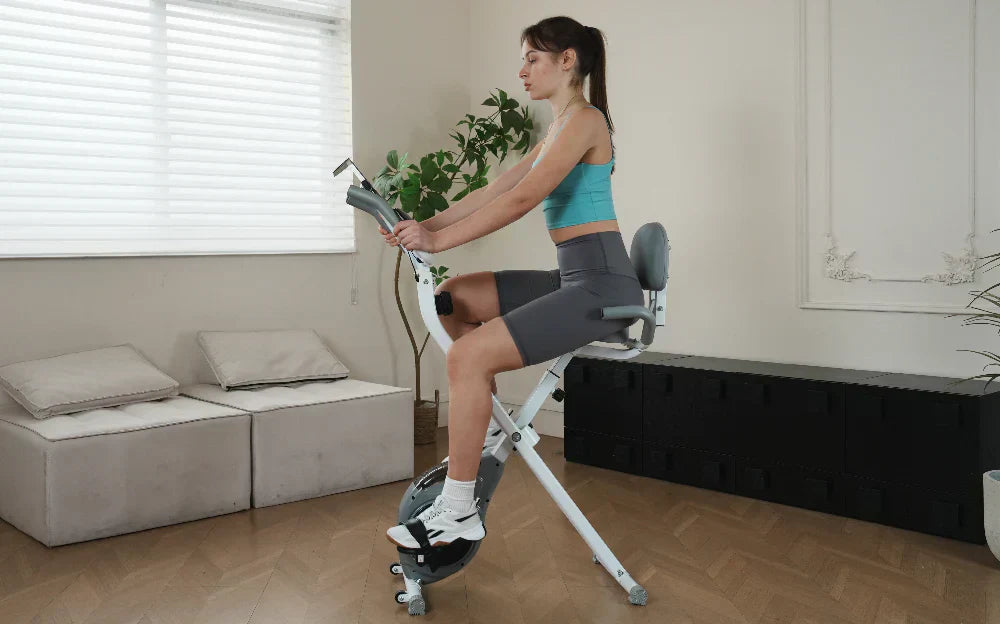When it comes to burning fat, cardio exercises are often the go-to option for many people. Treadmills and stationary bikes, such as the Tousains foldable exercise bike, are two of the most popular choices. Both are effective, but which one helps you lose more fat and achieve your fitness goals?
In this article, we will compare the treadmill and stationary bike in terms of calorie burn, joint impact, muscle engagement, and consistency to make the right choice.
How Weight Loss Works
Before choosing the right cardio equipment, it's important to understand the basics of weight loss. At its core, losing weight refers to creating a calorie deficit—burning more calories than you consume. Exercise plays a crucial role in increasing your Total Daily Energy Expenditure (TDEE).
Cardio workouts like running and cycling elevate your heart rate, leading to increased energy expenditure. The more intense and consistent your workouts are, the more calories you burn. Combined with a balanced diet, they help create a bigger calorie deficit.
Calorie Burn Comparison: Treadmill vs Stationary Bike
One of the simplest and most direct ways to assess weight loss efficiency is by comparing how many calories each machine burns. According to data from Harvard Health Publishing, a person weighing 155 pounds can expect to burn the following calories in 30 minutes:
- Treadmill (Running at 6 mph): 360 calories
- Stationary Bike (Cycling rigorously): 278 calories
It is obvious that treadmills burn more calories than cycling a stationary bike. This is especially true when incorporating interval training and using the incline feature.

Does this mean the treadmill is the better choice? Some may find it uneasy to use the treadmills for the first time. And many users may not sustain intense treadmill workouts due to joint pain or poor form. In contrast, a stationary bike is more joint-friendly and easy to use, providing a safer, more comfortable workout and contributing to greater calorie burn over time.
Impact on the Body: Joint Stress and Injury Risk
While calorie burn is important, safety and sustainability matter as well. The treadmill, especially during running, can be hard on your joints, with each step exerting force on the knees, ankles, and hips. Over time, this can lead to discomfort or even injuries, particularly in overweight individuals, older adults, or those with joint conditions.
On the other hand, the stationary bike is low-impact and joint-friendly. The seated position takes pressure off the joints, making it ideal for beginners, people with injuries, or those carrying excess body weight. Some users may find long cycling sessions boring. Fortunately, many models, including Tousains foldable exercise bike, are designed with a large device holder, allowing you to pedal while watching your favorite shows.
Muscle Engagement and Afterburn Effect
The treadmill activates large lower body muscles, such as the quads, glutes, calves, and hamstrings, especially when using incline features or incorporating sprint intervals. This full-body effort can elevate your heart rate faster and lead to a higher afterburn effect (EPOC), where your body continues to burn calories even after the session ends.
The stationary bike primarily targets the quads and calves. Increasing the resistance can add glute engagement. Tousains foldable exercise bike is equipped with 8 magnetic resistance levels, allowing for a tailored and quiet workout at home. For those who prefer lower-body toning, a stationary bike is an easy and convenient option.
Long-Term Consistency
A major but often overlooked factor in weight loss is consistency. Many people start with great ambition but quit quickly because the workout routine feels challenging and unachievable. The key is to find what you like and stick to it.

If you prefer using the stationary bike, just pick this machine. Though it might not provide the same calorie-burning efficacy as a treadmill, it is joint-friendly, and what matters more is that it is your preference! The same applies to treadmills.
Treadmill vs Stationary Bike, Which Is Better for Weight Loss?
The answer depends on many factors, such as your preferences and health conditions. Here are some recommendations for each criterion:
- Faster Calorie Burn in a Short Time: Treadmill
- Joint-Friendly Weight Loss: Stationary Bike
- Consistency and Ease of Use: Stationary Bike
- Higher Intensity Training (HIIT): Treadmill
- Beginner-Friendly: Stationary Bike
- Total Lower Body Engagement: Both (Treadmill slightly more)
If you’ve decided to choose the stationary bike, Tousains exercise bike will be your ideal home fitness companion! With adjustable resistance, height levels, magnetic, and collapsible design, it can fit well into your small apartments. Visit Tousains website and explore more features of this machine!
FAQ
Treadmill vs exercise bike for belly fat, which is better?
Neither targets belly fat directly. Overall, fat loss through consistent cardio and a calorie deficit is key.
Is 30 minutes a day on a bike enough to lose weight?
Absolutely—when paired with a proper diet and quality sleep, 30 minutes of cycling can contribute significantly to weight loss.
Which is more suitable for beginners?
Stationary bikes are easier to use and better for joint health, making them ideal for beginners.


